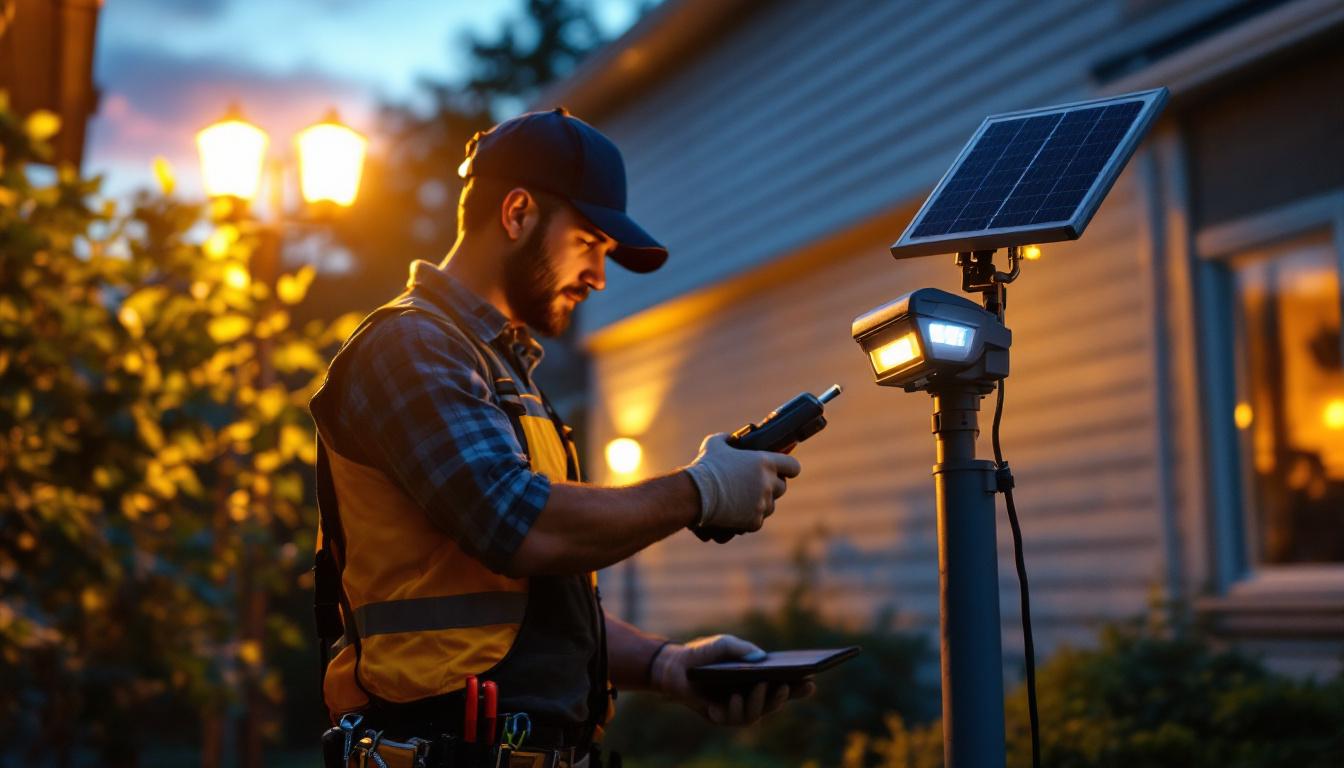
As the demand for sustainable energy solutions continues to rise, solar motion LED outdoor lights have become increasingly popular among homeowners and businesses alike. These innovative lighting options not only provide illumination but also contribute to energy conservation and environmental sustainability. However, for lighting contractors, the installation and maintenance of these systems come with their own set of challenges. Understanding these challenges is crucial for contractors aiming to provide high-quality service and meet client expectations.
Solar motion LED outdoor lights harness solar energy through photovoltaic cells, converting sunlight into electricity. This electricity powers the LED bulbs, which illuminate when motion is detected. The integration of motion sensors adds an extra layer of security and efficiency, as lights only activate when needed, thus conserving energy. These lights are particularly beneficial for outdoor spaces, where traditional electrical wiring can be cumbersome and expensive. By utilizing solar energy, homeowners can reduce their carbon footprint while enjoying enhanced safety and convenience.
Contractors must be well-versed in the technology behind these lights to effectively communicate their benefits to clients. This includes understanding the different types of solar panels, battery storage systems, and LED technology. Knowledge of these components will enable contractors to make informed decisions regarding product selection and installation practices. Additionally, familiarity with the various brands and models available on the market allows contractors to recommend solutions that best fit their clients’ needs, whether it be for residential, commercial, or public spaces. Furthermore, educating clients about the long-term cost savings associated with solar lights can help in promoting their adoption.
One of the foremost challenges lighting contractors face is selecting the right products for specific applications. The market is flooded with various models, each claiming to offer superior performance. Factors such as battery life, light output, and motion detection range can vary significantly between products. Contractors must assess the specific needs of each project, considering the location, intended use, and client preferences. For instance, a well-lit pathway may require lights with a broader beam angle and higher lumen output, while a secluded garden area might benefit from lights with a longer motion detection range to ensure security without being overly intrusive.
Moreover, ensuring that the selected products comply with local regulations and standards is essential. This often requires staying updated on industry trends and technological advancements, which can be a daunting task given the rapid pace of innovation in solar technology. Contractors may find it beneficial to participate in industry workshops and training sessions to stay informed about the latest developments. Additionally, establishing relationships with reputable suppliers can provide access to valuable resources and insights, helping contractors navigate the complexities of product selection more effectively. As the demand for sustainable lighting solutions continues to grow, being knowledgeable about the latest products and technologies will not only enhance a contractor’s credibility but also improve client satisfaction.
Proper installation of solar motion LED lights begins with a thorough site assessment. Contractors must evaluate the location for adequate sunlight exposure, as insufficient sunlight can lead to poor performance and reduced battery life. This involves not only checking for shading from trees or buildings but also considering seasonal changes that may affect sunlight availability. For instance, the angle of the sun changes throughout the year, which can impact how much light reaches the solar panels. A well-conducted site assessment can also identify potential obstacles such as nearby structures that may cast shadows during peak sunlight hours, allowing for strategic placement of the lights to maximize efficiency.
In addition, the physical installation process can present challenges. Mounting solar lights in optimal positions often requires specialized tools and techniques, particularly in areas with uneven terrain or where access is limited. Ensuring that the lights are securely installed while maintaining aesthetic appeal can be a delicate balancing act. For example, in gardens or landscaped areas, contractors may need to consider not only the functionality of the lights but also how they blend with the natural surroundings. This could involve using decorative mounts or concealing wiring to preserve the visual integrity of the space. Moreover, weather conditions can add another layer of complexity; rainy or windy days may hinder installation efforts and require careful planning to ensure safety and efficiency.
While solar lights are designed to operate independently, many installations may require additional wiring for features such as remote controls or smart home integration. This can introduce complications, especially when retrofitting existing systems. Contractors must be adept at troubleshooting wiring issues and ensuring that all components work seamlessly together. Additionally, the integration of smart technology often necessitates a deeper understanding of network connectivity, as contractors may need to configure Wi-Fi settings or Bluetooth connections to enable remote access and control. This added layer of complexity can be daunting, particularly for those who are more accustomed to traditional electrical installations.
Furthermore, understanding how to integrate solar lights with other outdoor lighting systems can be challenging. This requires a comprehensive understanding of both solar technology and traditional electrical systems, making it essential for contractors to possess a diverse skill set. For instance, they must be familiar with different voltage requirements and compatibility issues that may arise when combining solar and wired systems. The ability to navigate these challenges not only enhances the functionality of the lighting setup but also ensures that homeowners can enjoy a cohesive outdoor lighting experience. As technology continues to evolve, staying updated on the latest advancements in solar and smart lighting solutions is crucial for contractors aiming to provide the best service to their clients.
Although solar motion LED lights are generally low-maintenance, they do require periodic checks to ensure optimal performance. Contractors must educate clients on the importance of keeping solar panels clean, as dirt and debris can significantly hinder their efficiency. This may involve scheduling regular maintenance visits or providing clients with guidelines for self-maintenance.
Battery replacement is another critical aspect of maintenance. Over time, batteries can lose their ability to hold a charge, leading to diminished performance. Contractors should be prepared to advise clients on when to replace batteries and which types are most suitable for their specific lighting systems.
Environmental conditions can greatly impact the performance and longevity of solar motion LED lights. Factors such as extreme temperatures, humidity, and exposure to harsh weather can affect both the solar panels and the LED components. Contractors must be knowledgeable about how different materials and technologies withstand various environmental conditions to ensure that they recommend products that will last.
Additionally, understanding the local climate can help contractors suggest optimal installation locations that minimize the impact of weather-related wear and tear. This proactive approach can enhance customer satisfaction and reduce long-term maintenance costs.
One of the significant challenges contractors face is managing client expectations regarding solar motion LED lights. While these systems offer numerous advantages, such as energy savings and ease of installation, they also come with limitations. For example, performance can vary based on sunlight availability, and clients may not always understand the implications of this variability.
Contractors must take the time to educate clients about the benefits and limitations of solar technology. This includes discussing factors such as battery life, light output, and the potential need for additional maintenance. By providing clear and honest information, contractors can build trust and ensure that clients have realistic expectations about their solar lighting systems.
After installation, ongoing support is crucial for maintaining client satisfaction. Contractors should be available to address any questions or concerns that may arise regarding the operation of solar motion LED lights. This could involve offering troubleshooting assistance, providing maintenance tips, or even conducting follow-up visits to assess performance.
Establishing a strong relationship with clients can lead to repeat business and referrals. By demonstrating a commitment to customer service, contractors can differentiate themselves in a competitive market and foster long-term loyalty.
Lighting contractors must navigate a complex landscape of local regulations and building codes when installing solar motion LED lights. Different municipalities may have varying requirements regarding energy efficiency, safety standards, and environmental impact. Staying informed about these regulations is essential to avoid potential legal issues and ensure compliance.
Contractors should also be aware of any incentives or rebates available for solar installations, as these can significantly influence client decisions. Understanding the regulatory environment can position contractors as knowledgeable experts, enhancing their credibility and appeal to potential clients.
The solar lighting industry is continuously evolving, with new technologies and standards emerging regularly. Contractors must commit to ongoing education to stay abreast of these changes. This may involve attending workshops, participating in industry associations, or engaging with manufacturers to learn about the latest innovations.
By keeping up with industry standards, contractors can ensure that their installations meet the highest quality benchmarks. This commitment to excellence can lead to improved performance, increased customer satisfaction, and a stronger reputation in the marketplace.
The rise of solar motion LED outdoor lights presents both opportunities and challenges for lighting contractors. By understanding the technology, addressing installation and maintenance challenges, educating clients, and navigating regulatory requirements, contractors can position themselves for success in this growing market. Embracing these challenges not only enhances the contractor’s skill set but also contributes to a more sustainable future for the lighting industry.
As the landscape of outdoor lighting continues to evolve, staying informed and adaptable will be key to overcoming obstacles and delivering exceptional service. By focusing on quality, education, and customer support, lighting contractors can thrive in the competitive world of solar motion LED outdoor lights.
Ready to overcome the challenges of solar motion LED outdoor lights and lead the way in sustainable lighting solutions? LumenWholesale is here to support you every step of the way. Our extensive selection of spec-grade lighting products is designed to meet the highest industry standards, ensuring that you deliver reliable and high-performance lighting to your clients. With unbeatable wholesale prices and the convenience of free shipping on bulk orders, you can provide premium lighting solutions without the premium cost. Elevate your lighting projects by choosing Wholesale Lighting at the Best Value with LumenWholesale, where quality, affordability, and contractor support come together seamlessly.

Discover the pros and cons of metal lamp posts versus alternatives to help lighting contractors make informed choices.

Discover how to future-proof your lighting projects with the first LED technology.

Discover innovative cost-saving strategies for lighting contractors with strip lights.

Discover the ultimate guide to recessed kitchen lights, covering everything from design tips to installation advice.